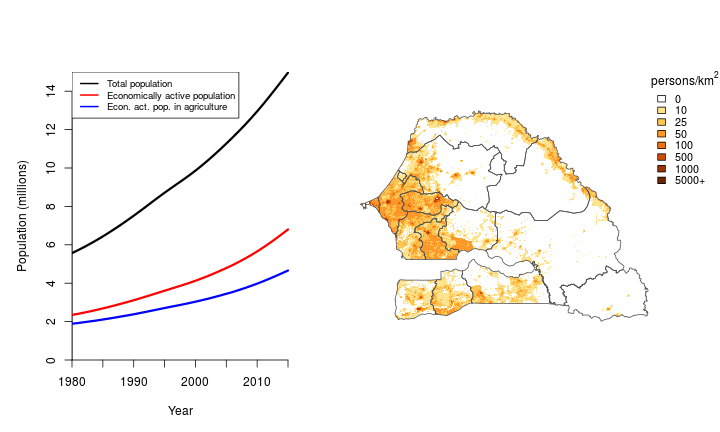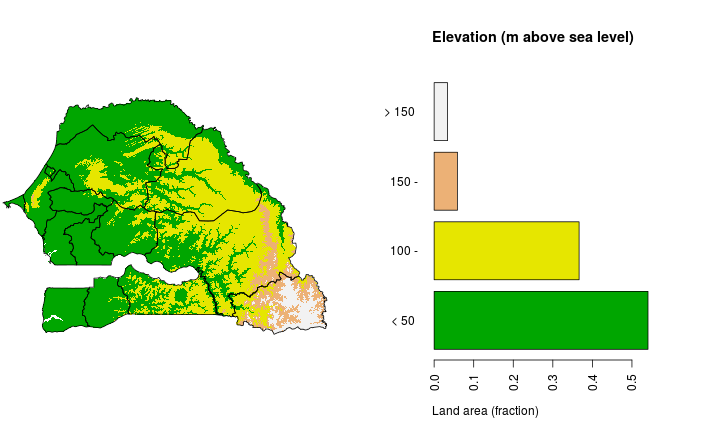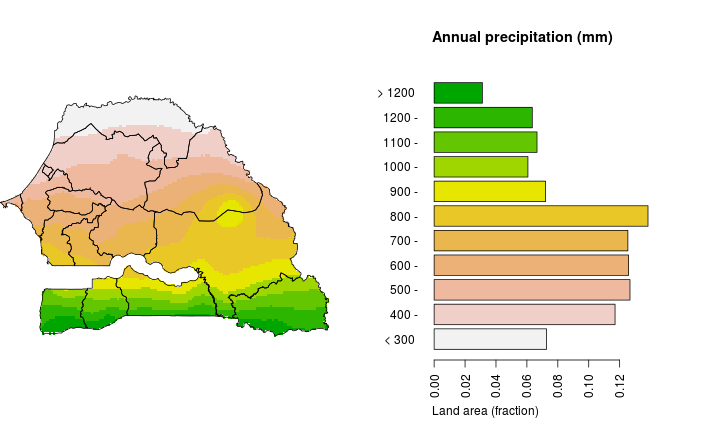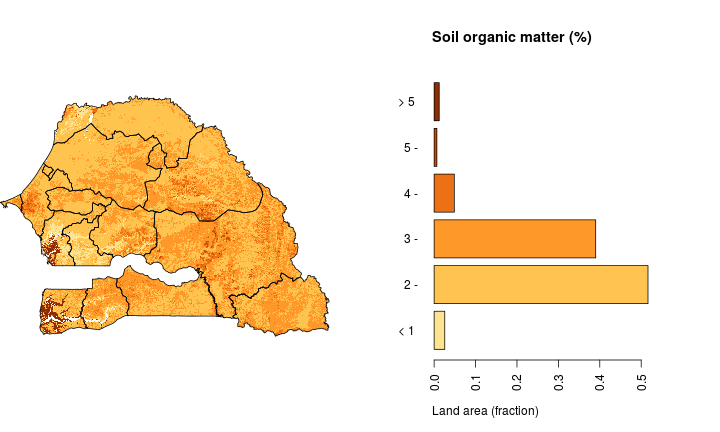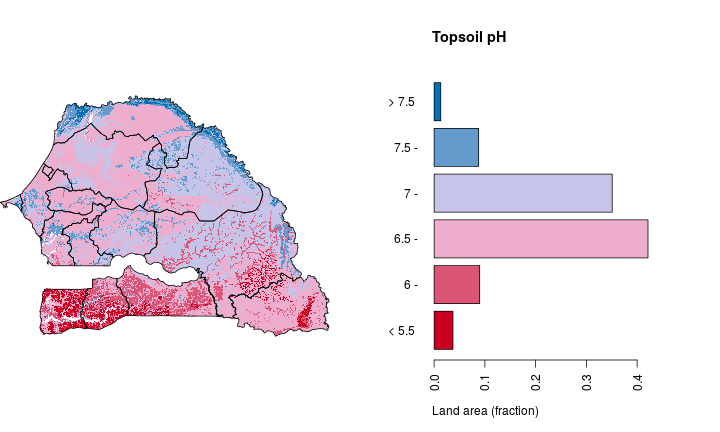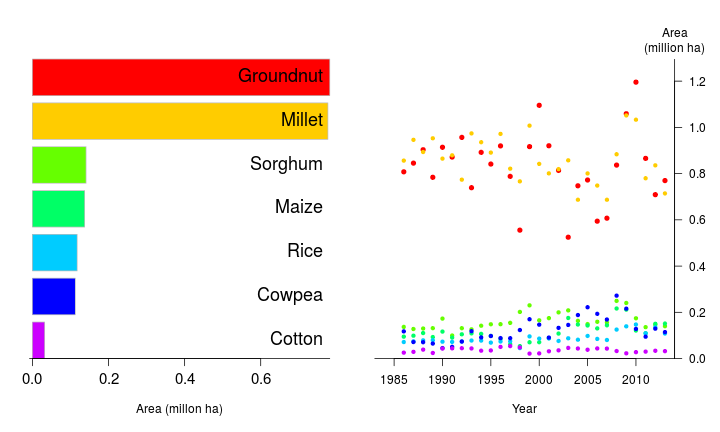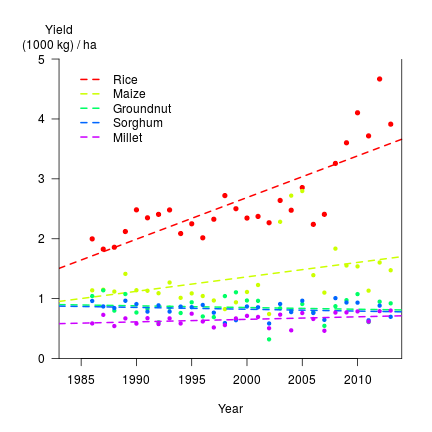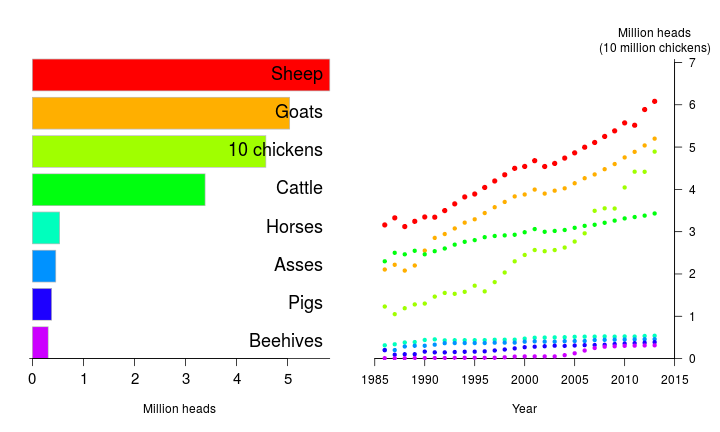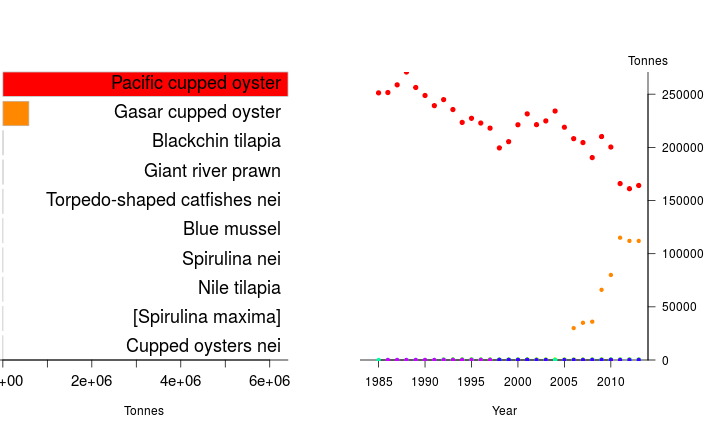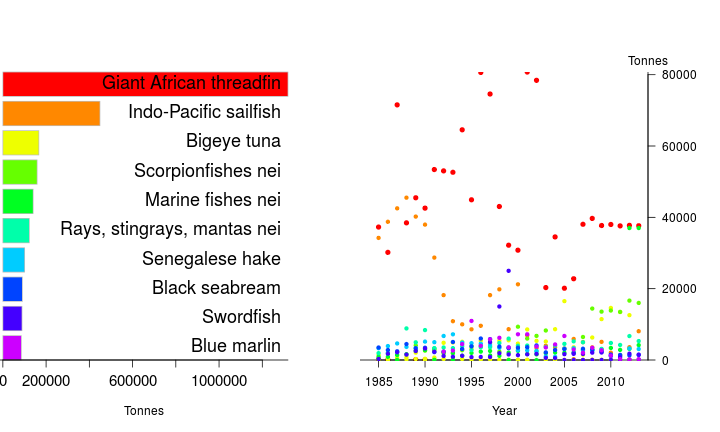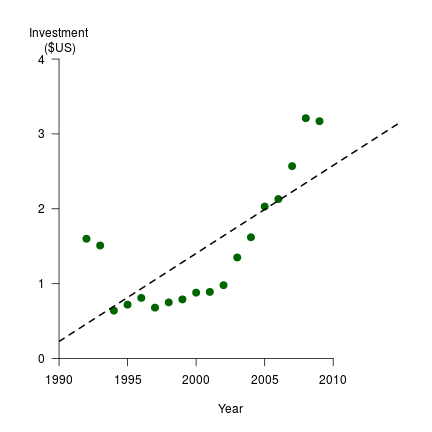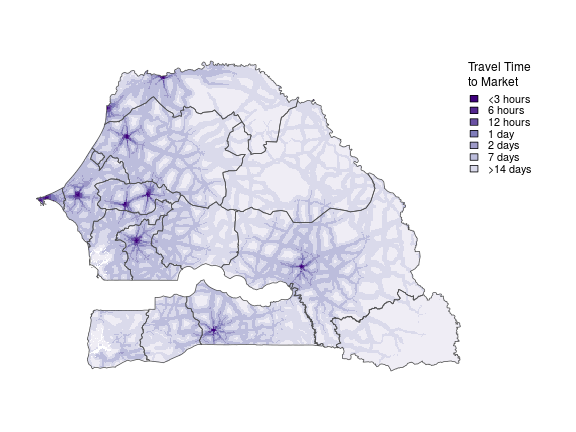Senegal¶
Introduction¶
The USAID Feed the Future Initiative in Senegal focuses primarily on rice (irrigated and rain-fed), millet, maize, and fisheries. The Initiative makes key investments in efforts to increase inclusive growth in the agriculture sector, productivity and market linkages in important value chains, and the capacity of human resources. It also invests in projects that seek to improve the nutrition status of women and children, enhance natural resource management, rural infrastructure, and policy reform. The Initiative coordinates with the US Global Climate Change and Global Health initiative. A list of activities and projects can be found here.
Senegal is involved in several other Feed the Future Innovation Labs for Collaborative Research. It participates in the Lab for Food Processing and Post-Harvest Handling that has two core research components: grain drying and storage, and food processing and nutrition. The Lab for Climate-Resilient Cowpea is a cowpea-breeding project, which emphasizes breeding traits such as resistance to drought-associated fungal pathogens, insects, and disease. The Lab for Sorghum and Millet aims to contribute to advancing technology and knowledge on adaptation, resilience, and more profitability of sorghum and millet-based production systems and value chains. The Lab for Integrated Pest Management has several projects, one of which includes advancing pest management packages for cabbage, potato, and tomato. The Lab for Grain Legumes has two projects. The first focuses on impact assessment of dry grain pulses investment and the other focuses on genetic improvements to cowpea to overcome drought and biotic constraints. The Lab for Market Access has a project that assesses the impacts of complementary development programs such as training and subsidization of inputs and/or capital.
Senegal’s geography and administrative borders follow patterns of ethnicity (Gottlieb 2014), as does its agricultural production.
Senegal is located between a latitude between 12.3 °N and 16.7 °N. The total land area is about 193 thousand km2. The country is administratively subdivided into 15 Région (Regions), and these are further sub-divided into 46 Département (Departments).
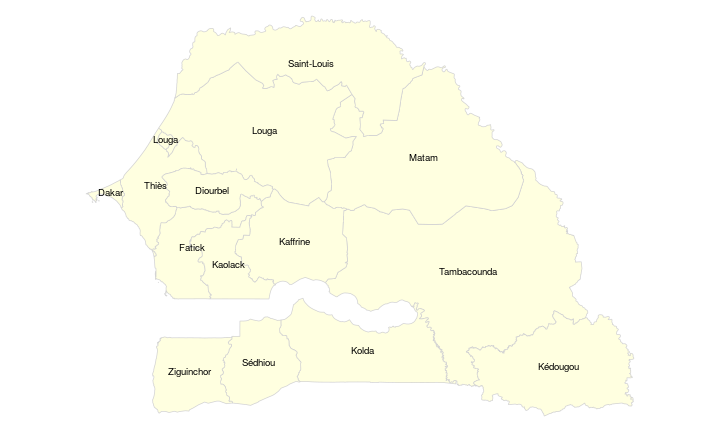
Administrative Divisons Map
The regions of Senegal
Human development¶
Population¶
Senegal has about 15 million inhabitants. The population has increased 2.3 fold over the past 30 years. The economically active population is 6.8 million, 69% of which is employed in agriculture (down from78% in 1985). The rural population was 62% in 1985 and now it is 56%.
Development¶
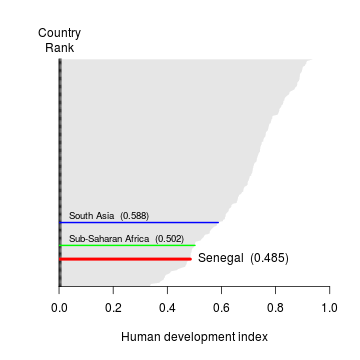
Human Development Index ranking and value
Human Development Index ranking for Senegal. Data source: UNDP.
Gender¶
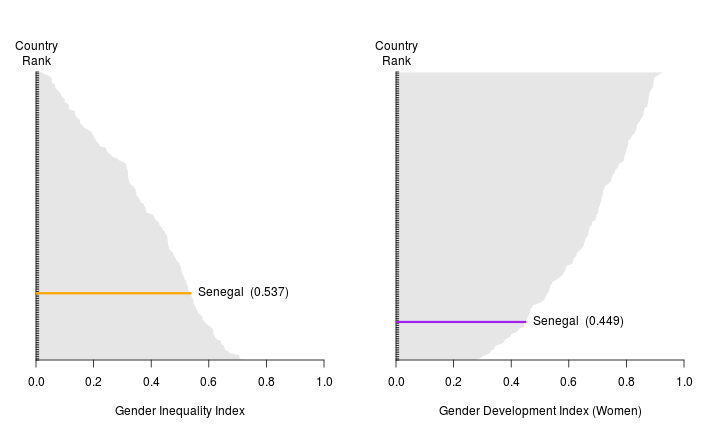
Gender Inequality and Development Indexes
Gender Inequality and Development Indices for Senegal. Data source: UNDP.
Health and nutrition¶
Under-five mortality in Senegal dropped from 29% in 1970 to 5.5% in 2013 (UNICEF, 2014). Life expectancy at birth is only 63, but this is up from merely 39 in 1970 (UNICEF, 2014). While wasting has remained around 10% since 1992, stunting and underweight have varied between surveys. According to the Senegal Demographic and Health Surveys (SDHS) since 1992, stunting decreased from 30% in 1992 to 19% in 2005, increased to 27% in 2010, and decreased back to 19% in 2012-2013. Less drastically, underweight decreased from 18% in 1992 to 14% in 2005, increased to 18% in 2010, and decreased to 16% in 2012-2013. All three child anthropometric indicators are higher among rural and poor households. The south seems to have a greater burden of stunting and underweight, while the north has the greatest burden of wasting (National Agency of Statistics and Demography (NASD & ICF International, 2013).
Almost no women have short stature (height < 145 cm) in Senegal. The 2011 SDHS estimates that 22% of women are underweight (BMI < 18.5) and nearly the same proportion are overweight or obese (21.3% have a BMI ≥ 25). Unsurprisingly, rural households have higher rates of underweight women, and urban households have more than double the prevalence of overweight or obesity in women (NASD & ICF International, 2012). Overweight and obesity is clearly positively correlated with income, but underweight is not as simple. Women in the highest wealth quintile have the lowest rate of underweight, but women in the fourth wealth quintile have nearly the same rates as the lowest quintile, 24.9% and 25.8%, respectively (NASD & ICF International, 2012). Men, on average, are more likely to be underweight (26.7%) than women (NASD & ICF International, 2012). Conversely, men are far less likely to be overweight or obese (8.9%, NASD & ICF International, 2012). Men from urban and wealthy households are more likely to be overweight or obese and less likely to be underweight than men from rural and poor households.
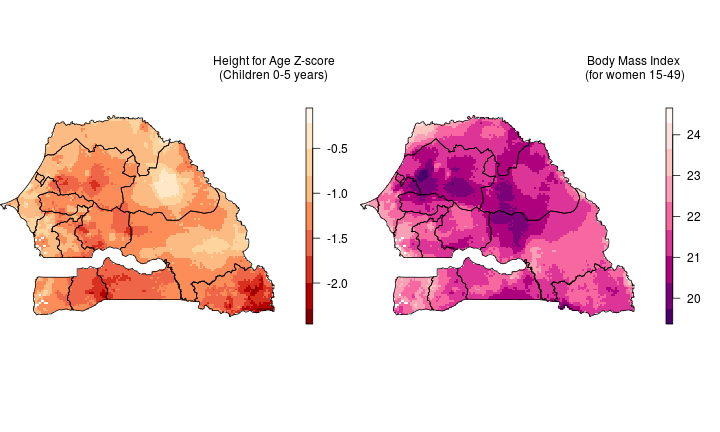
Child height-for-age Z-score and women’s body mass index
Average height-for-age Z-score for children (a child with a score less than -2 is considered stunted), and body mass index for women. Data source: DHS.
Micronutrients¶
To our knowledge, no nationally representative micronutrient biomarker survey has been conducted in Senegal apart from the HemoCue anemia testing in the SDHS. Anemia in children is high (71.2%) in Senegal, but down from 76.4% in 2011 (NASD & ICF International, 2013). Prevalence of anemia in women is 58.5% according to the 2011 SDHS. Anemia is much lower in men (31.2%, NASD & ICF International, 2012). About 62.6% of mothers took iron syrup or tablets 90 days or more during pregnancy of the most recent birth. Less than half (45.4%) received a vitamin A dose postpartum. Among children 6-59 months, 78.4% were given vitamin A supplements in the past 6 months, 12.8% were given iron supplements in the previous 7 days, and 55.5% were given deworming medication in the past six months (NASD & ICF International, 2012). Complementary feeding of foods rich in vitamin A and iron to children 6-23 months is inadequate. Only 47% of households have adequately iodized salt (≥ 15 ppm), 15.9% have inadequately iodized salt, and 8.6% have no salt (NASD & ICF International, 2012).
About one in five people do not consume adequate diets in Senegal (WFP, 2014). Only five percent of food consumed is from the household’s own production; a large majority of food consumed in both rural and urban settings is purchased from market. Cereals contribute about two thirds of the caloric energy supply (FAO, 2010). Rice is the largest share of cereal consumption, though millet, sorghum, wheat, and corn are also consumed. Fish, livestock, and milk are the main sources of animal protein. Few recent studies have been conducted on diet and food consumption in Senegal at the national level. More data is vital to understanding how to best improve nutritional status in Senegal.
The New Alliance for Food Security and Nutrition works on policy changes and investments African agriculture to benefit smallholder farmers and reduce hunger and poverty. They have a country report for Senegal.
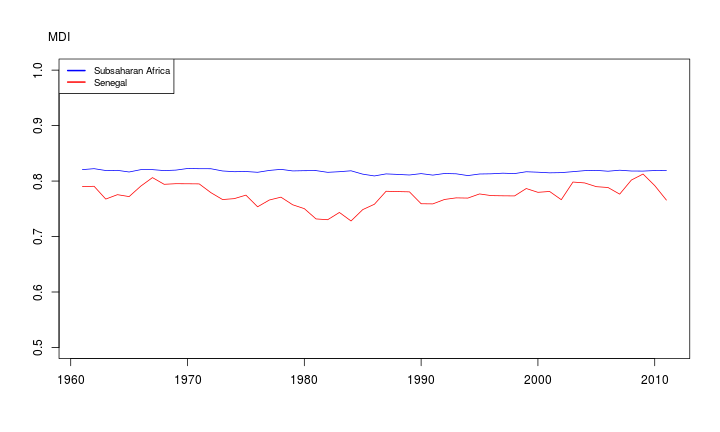
MicroNutruent Density Index
Micronutrient Density Index (MDI) between 1961 and 2011. Source: Beal et al.
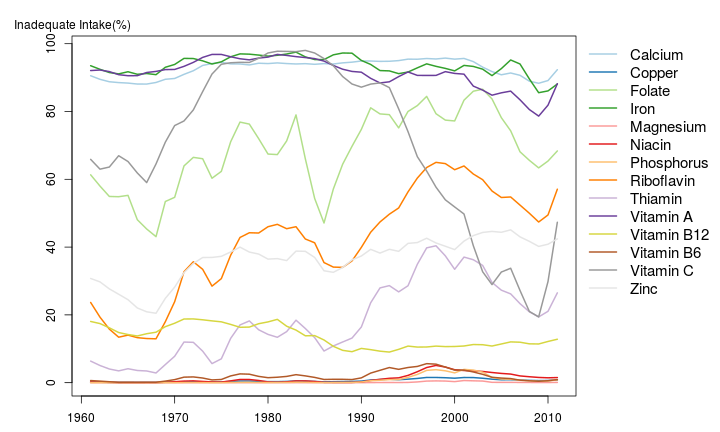
Prevalence of Inadequate Nutrient Intake
Estimated prevalence of inadequate intake (%) of micronutrients between 1961 and 2011. Source: Beal et al.
Land and water resources¶
Elevation¶
The elevation of Senegal is between -10 and 540 meters above sea level. Half the land area is below 50 meter and in between 30 and 60 meter.
Climate¶
The climate of Senegal is tropical with two distinct seasons: the dry season and the rainy season. Senegal’s climate is Sahelian, with a gradient of gradually increasing rainfall from north to south. The rainy season changes slightly with latitude, from June-October in the south, from July-September in the north. Average rainfall is subject to great interannual variation (FAO AQUASTAT).
The annual average temperature in Senegal is between 24.5 and 29.8 °C. The median annual average temperature is 27.7 °C and half the land area has an annual average temperature between 27.1 and 28.3 °C. For more details see the monthly temperature maps. For projected future climate change, see these maps.
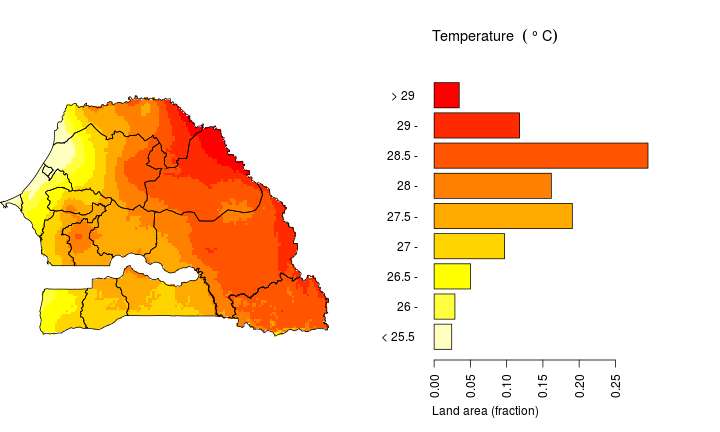
data source: WorldClim
Average annual mean temperature (°C) for 1950-2000 in Senegal. Source WorldClim
The annual total precipitation in Senegal is between 170 and 1380 mm. The median is 640 mm and half the land area has an annual total precipitation between 440 and 860 mm. For more details see the monthly precipitation maps. For projected future climate change, see these maps.
Soils¶
Water¶
Senegal has an expansive river system as well as extended coastline along the Atlantic Ocean. The most important river is the Senegal River on the northern border with Mauritania. The Senegal river basin covers 37% of the land area of Senegal. Other important river systems include the Gambia River in central Senegal (30%), the Casamance river (11%), and the Kayanga River in the south. Rivers in Senegal exhibit a tropical pattern in that the river flow varies based on season; rivers follow the rains and are at their peak in August and September.
An estimated 93% of the water used by Senegal is for agriculture. Despite this, irrigation intensity is relatively low, covering only 4.8% of the cultivated area in Senegal in 2002. The potential for irrigation is much higher. About 25% of potentially irrigable area was irrigated in 2002. In the irrigated areas, rice is the main crop, with legumes and sweet potatoes also present (FAO AQUASTAT).
Senegal does not have significant groundwater resources, with renewable sources estimated at 3.5 km3/year. There are three different types of groundwater aquifer in Senegal: surface, a limestone/intermediate system, and a deep aquifer system in sandstone (FAO AQUASTAT). Groundwater resources are sensitive to saltwater intrusion (Faye et al. 2005).
Senegal has several major dams. The largest is the Diama Dam on the Senegal River, with a reservoir capacity of 250 million m3 (FAO AQUASTAT Dams Database). The Kayanga River in the south is equipped with two dams: the Anambé (in Guinea-Bissau)and Ndiandouba.
Water policy and investment¶
The privatization of Senegal’s water supply and distribution is considered a token success story in Africa, and is attributed to major gains in access to quality water in both urban and rural areas. The delivery of water is managed through a public-private partnership, where the Government of Senegal contracts to the national Senegalese water company that manages operations, maintenance, and infrastructure. The 1981 Water Code establishes the central government as the agent with authority over all water resources. It also establishes Water User Associations (WUAs), which are federated entities that oversee water allocation, management, and fee collection across several villages. Individuals pay for drinking water, and landholders can use surface water accumulating on their land. Although the WUAs are oversee local water use, the Ministry of Habitat, Construction, and Hydraulics can suspend or revoke water rights if the user does not use them or causes pollution. Importantly, and like land tenure legislation, water laws do not address water rights in pastoral environments (USAID 2010b).
The Ministry of Habitat, Construction, and Hydraulics is responsible for supplying water in rural areas. The Directorate of Management and Planning of Water Resources oversees groundwater resource use and the Senegalese national water company is in charge of all maintenance, infrastructure development, and operations.
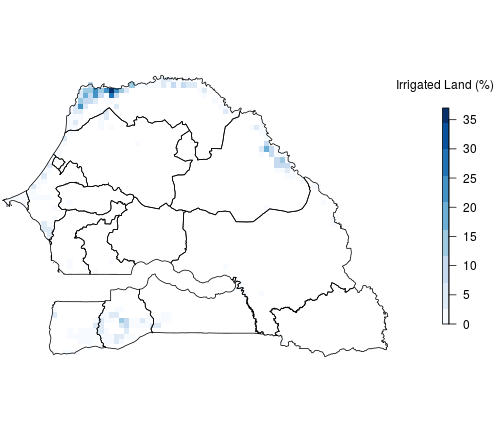
Map of Irrigated Agricultural Land
Percentage of agricultural land that is irrigated. Data source: GMIA
The World Bank/IFC has been active with weather insurance programs in the country, with an insurance pilot in 2011, with market launch in 2012. The insurance covers drought risk for groundnut and maize farmers, with a total insurance portfolio of $458,304 as of 2014. The project reaches 4,035 households, and has had a total of $31,215 in insurance payouts so far.
The R4 Rural Resilience Initiative, a joint FP-Oxfam Initiative, has been active in Senegal since November 2012. R4 seeks to improve resilience for smallholder farmers by providing training in water management technologies as well as providing weather insurance.
Land tenure¶
Senegal has generated legislation on land tenure, but has not formalized or enforced all procedures. The 1964 National Domain Law states that over 95 percent of all land is state-owned and that municipality leaders have control over land allocation and management. The 1996 Decentralization Law clarified local land governance processes and structures at the regional and municipal levels in both urban and rural areas. Elected rural councils are responsible for assigning and revoking land use rights over ‘territorial’ lands; the central government is responsible for allocation of ‘pioneer’ lands. The central government is allowed to reclassify territorial lands as pioneer lands in order to regain control. Reclassification often occurs when commercial players are interested in obtaining quality farmland, especially in the river valley (USAID 2010b).
Rural councils have considerable discretionary power over land allocation. The primary means of accessing land is through inheritance, leasing, borrowing, land purchase, and allocations – all from local rural councils. Because rural councils have such high discretion and are so localized, many types of tenure systems can exist in a single region. This adds complexity to land tenure. Customary law, religion, and political party membership perpetuate inequities to land access. Council members are often elite landholders and chiefs, and thus there are instances when land allocations and sales benefit elite members and disadvantage lower caste farmers. There are also instances when rural councils collude with commercial interests at the expense of poorer farmers in areas where land is highly productive and valuable. Finally, there is no formal expropriation and compensation procedure for expropriated land taken for projects such as irrigation development (USAID 2010b).
Rights to land for pastoralism have largely been ignored, creating conflict between pastoralists and settled farmers and leading to land degradation. The land tenure laws assert that land should be allocated in a way that achieves the most “productive” results. Productivity, in this case, is defined as land put under intense cultivation. Forest management and pastoralism are not considered productive activities. Defining productivity this way gives precedent to commercial interests. The 2004 Framework for Agro-Sylvo-Pastoral Development is a broad policy that aims to develop rural land rights and use, including commercial agriculture, forest protection, and the development of the livestock sector. Yet no legislation has been generated to support the implementation of the framework. Senegal also has a fairly active informal market in land sales and leases (USAID 2010b).
The Ministry of the Interior and the Ministry of Habitat, Construction, and Hydraulics are the two agencies most involved in land administration and law.
Food production¶
Crop production¶
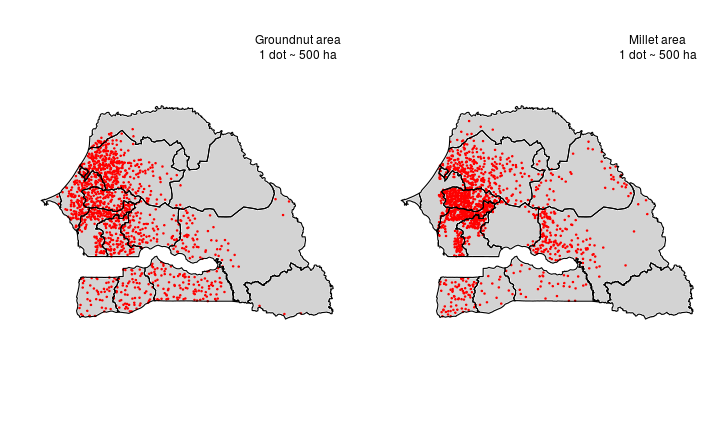
Cultivation Distribution
Annual linear growth rates of crop yield over the past 30 years, for the main five crops , were between -3.1 (Sorghum) and 69.5 (Rice) kg/ha
Livestock¶
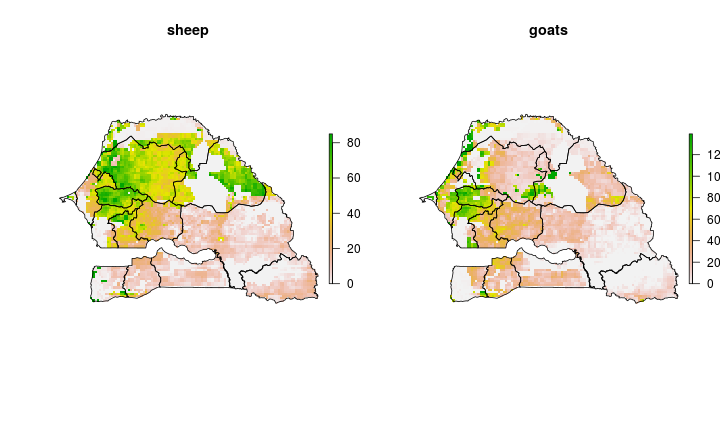
Livestock Distribution
Spatial distribution (head per km2) of sheep and goats in Senegal. Data source: Gridded Livestock of the World. More livestock maps.
Intensification¶
Senegal is the one of the largest net importers of food in the world (Stads and Sene 2011), importing 70 percent of its cereals (mainly rice and wheat). Despite its large livestock sector, it is also a net importer of meat. During the 2007-2008 food crisis, the government implemented subsidies to protect both consumers and farmers. The government has maintained focused on reducing its dependence on imports by augmenting production (Stads and Sene 2011).
Rice is Senegal’s staple crop, and since the 1980s, the country has emphasized rice production through subsidies, extension, and infrastructure , but has failed to compete commercially with imported rice (Dermont and Rizzotto 2012). This is partly due to the government’s focus on urban populations and their efforts to import cheap rice from Asia (Khouma and et al. 2012). Principal exports include groundnuts and cotton (Stads and Sene 2011); seafood accounts for one quarter of the country’s exports (Dermont and Rizzotto 2012). Although Senegal’s agriculture industry was liberalized in the 1970s and 1980s, the country has remained quite vulnerable to price shocks and food shortages.
The Senegalese government has established several agriculture policies. The 2004 Agriculture, Forestry, and Livestock Act aims to increase the quality of exports, soil management practices, land-use rights, and private investment in rural areas. Critics suggest that the policy outlines unrealistic goals, however, and gives too much power to the state (Mbaye 2005). The 2006 Return to Agriculture set investment goals for rural infrastructure like roads, electricity, and in attempts to slow the country’s high rural outmigration. In response to the 2008 food crisis, the Great Push Forward for Agriculture, Food, and Abundance (GOANA) was established to increase production and exports by 2015 through supplying farmers with fertilizers and seeds. GOANA, along with the National Rice Self-sufficiency Programme (PNAR), focused heavily on expanding rice production to meet domestic consumption needs. Although the policy outputs are considered successful, there is debate about whether increases in production and exports are due to increased rainfall and not from the policy (Stads and Sene 2011),
Subsidies for inputs such as fertilizer, seed, machinery, and fuel have been a mainstay in agricultural development in Senegal since 2004. The amount of subsidies provided has expanded as well, increasing from 75 million in 2001 to 36 billion ten years later (Seck, 2015). They have been used to enhance productivity in groundnuts, millet, sorghum, and maize. Although groundnut farmers have received the most assistance through subsidies for fertilizers and seed over the last 15 years, diversification priorities have resulted in increased financial supports to farmers growing other crops (Seck, 2015). Most of fertilizers have been subsidized at 50 percent, meaning the government pays for 50 percent of the farmer’s fertilizers through government-approved and registered tenders and the farmer purchases the remainder of their fertilizer through the private market (Bumb and et al., 2011). Farmers are responsible for obtaining their fertilizer from the suppliers’ warehouses, and 80 percent of the fertilizers on the market are government-approved tenders (ibid).
Nine public agencies are involved in agricultural research and development (R&D) in Senegal, but two thirds of the country’s agricultural researchers work in one agency, ISRA. Public research prioritizes food crops and privately funded research from companies like SENCHIM and SODEFITEX focus their research on the export crops (groundnuts and cotton). Spending on agricultural R&D has been relatively consistent since 2000, but new funding through the West Africa Agricultural Productivity Program (WAAPP) has increased the funding available for training researchers and purchasing improved equipment for research on grains. As of 2011, however, R&D public programs on rice and groundnuts continued to be underfunded (Khouma and et al., 2014). Many farmers participate in farmers’ organizations and receive benefits through services such as subsidized inputs and extension that these organizations offer.
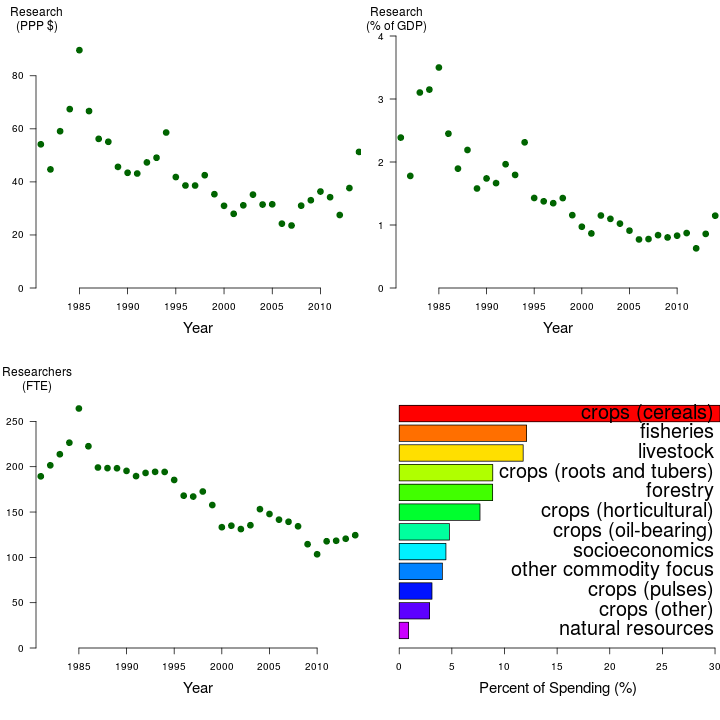
Investment in Agricultural Research
Investment in Agricultural Research over time and by commodity groups ( data source: ASTI).
Yield gaps¶
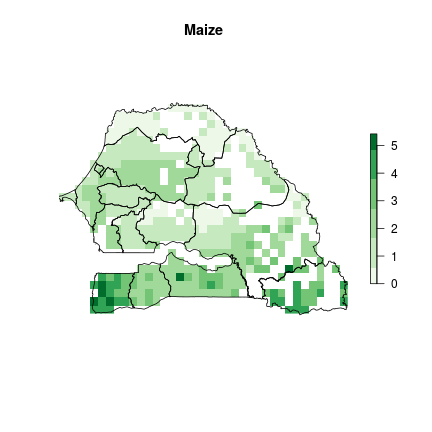
Yield Gap
Yield Gap (1000 kg / ha).
Selected research and development priorities and projects¶
The research programs within the CGIAR have a handful of projects in Senegal. The International Livestock Research Institute has several research agendas, of which focus on policy and capacity building, improved utilization and breed-types of dairy cattle, and the quantification of weather and climate impacts on health. The Climate Change, Agriculture and Food Security Research Program has several research agendas as well. The projects focus on seasonal forecast communication, optimal sowing time periods for irrigated and upland rice in the Senegal and Niger River, and the development of a climate-smart cereal-commodity sector.
FAO’s priorities in Senegal include increasing food security and the competitiveness of the agricultural sector through improved policies and social protection during crises, restoring and enhancing natural resource management, reducing bushfires and land degradation while protecting biodiversity, and strengthening early warning systems (Country Program Framework 2013-2017). The most recent Poverty Reduction Strategy Paper focuses on strategies to reduce Senegal’s dependence on food imports, enhance land-use planning, increasing irrigation, and research and extension. Specific agricultural objectives include modernizing equipment, supporting markets, improving access to lands, increasing agricultural research, and improving the management of the agricultural sector. Sub-sector objectives include improving the production of livestock through strengthening pastoral infrastructure and equipment, insurance systems, and the legislative and regulatory framework; restoring and restocking degraded fisheries, increasing commercial fish farming and credit, and boosting access to markets for fishery products; improving water management and use (including improvements to irrigation); improving access to nutritious food; and strengthening food crisis prevention systems (IMF PRSP 2013-2017).
In 2012, the African Development Bank (AfDB) financed the Project to Support Local Small-scale Irrigation (PAPIL). The project claims several accomplishments to date, including the construction of water runoff structures, micro-dams and weirs, and anti-salt structures. PAPIL significantly increased the potential and yields of the farmland, and helped some areas achieve self-sufficiency in rice production.
The US (African Development Foundation)[http://www.adf.gov/] supports many projects in Senegal
Nature conservation¶
About 25% of terrestrial Senegal is under some form of protection (IUCN & WDPA 2015). This includes two national parks (Category II), three habitat/species management areas (Category IV), and one managed resource protected area (Category VI), as defined by the IUCN. Across Senegal UNESCO has designated two natural areas as World Heritage Sites (Djoudj National Bird Sanctuary and [Niokolo-Koba National Park[(http://whc.unesco.org/en/list/153)), and three Biosphere Reserves. Additionally, the country contains two Ramsar Wetlands of International Importance.
Senegal is home to 46 species on the IUCN Red List of threatened and endangered species. This includes one species that is Extinct in the Wild, four listed as Critically Endangered, nine as Endangered, and 32 as Vulnerable. However, Senegal does not contain any sites noted by the Alliance for Zero Extinction as locations having an imminent risk of species extinctions.
None of the major global or regional environmental non-governmental organizations have current conservation programs operating in Senegal.
Global conservation prioritization methodologies have highlighted a total of 16% of Senegal as having conservation importance. This includes Important Bird Areas (14% of the country) and regions considered to be the Last of the Wild (2%) as defined by Wildlife Conservation Society. However, no area in the country is recognized as a Biodiversity Hotspot (Conservation International) or a Frontier Forest (Global Forest Watch). Nor does Senegal contain any portion of the Global 200 Ecoregion network (World Wildlife Fund).
The map on the left shows biodiversity conservation priorities generated by combining numbers of vertebrate species, (excluding reptiles), IUCN threatened species, and small-ranged species (data from Jenkins et al. 2013) per 10 km2 cell. Thus, the areas with the highest values (shown here in red) not only have the greatest diversity of species in Senegal, but also show those areas where species are or might become threatened with extinction. The map on the right highlights 17% of the terrestrial area of Senegal containing the highest conservation priority values (a 17% target was chosen in accordance with the 2010 Convention of Biological Diversity). The same analysis at both regional and global scales highlights 18% and 0% of the nation respectively as meeting the CBD targets as defined in this analysis.
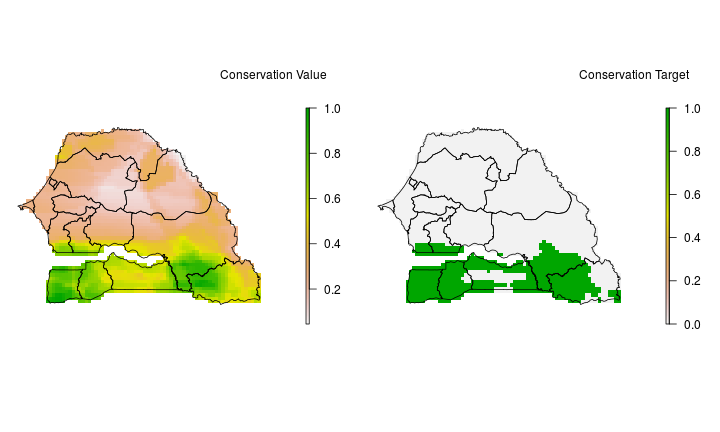
Conservation Priorities
Conservation Priorities.
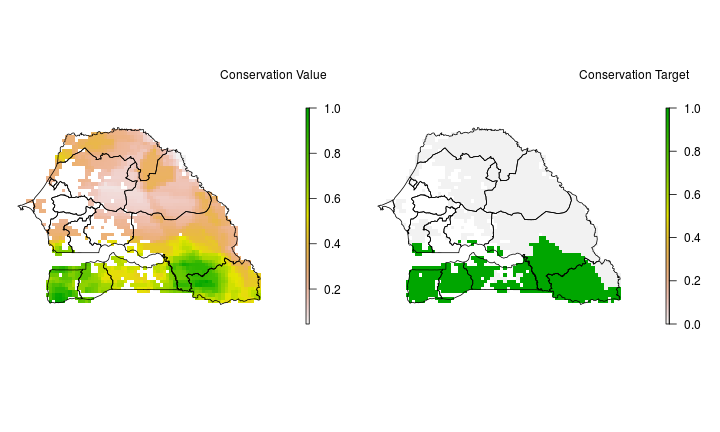
Conservation Priorities excluding Urban and Agricultural land
Conservation Priorities excluding Urban and Agricultural land.
Political system¶
Politics overview¶
Senegal is considered a relatively strong democracy in Africa. Although the executive has extensive constitutional authorities, Senegal has had two presidential elections in which the two main political parties alternated power. These alternations were mostly peaceful. Senegal has been relatively stable politically; the country has not experienced a coup.
Senegal has clientelistic, patronage-based, and personalistic politics, accompanied by powerful informal local institutions and elites (Gottlieb 2014). Recent presidents have hired and fired multiple prime ministers (Mbow 2008), which demonstrates both the president’s power and the personalistic nature of politics in the country. Despite its political peacefulness and its characteristics of electoral democracy, there is also evidence that Senegal has high levels of corruption (Inman and Andrews 2014), collusion, and is not very transparent.
Executive structure¶
Senegal has a president-parliamentary system. The president appoints the prime minister, and can hold the presidential position twice for seven-year terms. The president is elected via a runoff system. As noted, the presidential elections are competitive and alternations in power have been fairly peaceful. In the last few presidential elections, the winner has received approximately 50-65 percent of the vote. In the most recent presidential election in 2012, Macky Sall (the former prime minister) was elected and replaced Abdoulaye Wade after he served one term.
Electoral rules and party arrangement¶
Senegal was one of the first African countries to transition to multi-party democracy. The House in the National Assembly has 150 members. The National Assembly became unicameral after the Senate was eliminated in 2012 due to public dissatisfaction with the second chamber and its expenditure trends. Although the details of the electoral system are somewhat complicated, the basics are that legislators are elected via a mixed-member system. 90 of the 150 members are elected through the nominal tier in 45 electoral constituencies and 60 are elected via nationwide proportional representation. Some scholars suggest that the National Assembly is fairly weak and prone to factionalism (Mbow 2008).
Decentralization¶
The 1996 Law on Decentralized transferred governing tasks to the local government, but the capacities of local government was fairly restricted in earlier years. The Ministry of Planning and Local Government was established in 2009 to oversee decentralization. The decentralized structure includes a regional government, with an appointed governor and directly elected regional council, 113 municipal governments led by a major and directly elected municipal council, and 370 rural communities, made up of a directly elected rural council. The central government accounts for approximately 20 percent of the total expenditure of local governments (World Bank 2013), but local governments are working on increasing their local revenue. Proportional representation is used in elections at local levels (local_democracy).
References¶
- Bumb, Balu, and et al. 2011. Policy Options for Improving Regional Fertilizer Markets in West Africa. Washington DC: IFPRI. IFPRI Discussion Paper 01084.
- Dermont, Matty, and Amy Rizzotto. 2012. “Policy Sequencing and the Development of Rice Value Chains in Senegal.” Development Policy Review 30(4): 451–72.
- Faye, Serigne, et al., 2005. Groundwater salinization in the Saloum (Senegal) delta aquifer: minor elements and isotopic indicators. Science of the Total Environment 343.1: 243-259.
- Food and Agriculture Organization (FAO). (2010). Senegal Nutrition Country Profile. Rome. FAO.
- Gottlieb, Jessica. 2014. Local Leader Influence, Electoral Behavior, and Redistribution: A Research Design for a Lab-in-the-Field Experiment in Senegal. Working Paper: 1–24.
- Inman, Kris, and Jo Andrews. 2014. “Corruption and Voting in Senegal: Evidence from Experimental and Survey Research.” African Jounral of Political Science and International Relations 8: 1–15.
- Khouma, Mamadou et al. 2012. West African Agriculture and Climate Change. IFPRI.
- Mbaye, A. 2005. Sanitary and Phytosanitary Requirements and Developing-Country Agro-Food Exports: An Assessment of the Senegalese Groundnut Sector. World Bank. Agriculture and Rural Development Discussion Paper.
- Mbow, Penda. 2008. “Senegal: The Return of Personalism.” The Journal of Democracy 19(1): 156–69.
- National Agency of Statistics and Demography (NASD) (Senegal), & ICF International. (2013). Continuous Demographic and Health Survey in Senegal (Continuous DHS) 2012-2013. Calverton, Maryland, USA: ANSD and ICF International.
- National Agency of Statistics and Demography (NASD) (Senegal), & ICF International. (2012). Senegal Demographic and Health and Multiple Indicator Cluster Survey (EDS-MICS) 2010-2011. Rockville, Maryland, USA: ANSD and ICF International.
- Peterson,J., Kalende,M., Sanni,D. & N’Gom,M. 2006. The potential for integrated irrigation-aquaculture (IIA) in Senegal. In M. Halwart & A.A. van Dam, eds. Integrated irrigation and aquaculture in West Africa: concepts, practices and potential, pp.95–116. Rome, FAO. 181 pp.
- Seck, Abdoulaye. 2015. Fertilizer Subsidy and Agricultural Productivity in Senegal. Cheikh Anta Diop University (Unpublished): 1–18.
- Stads, Gert-Jan, and Louis Sene. 2011. Private Sector Agricultural Research and Innovation in Senegal. ASTI CGIAR.
- The Hunger Project. 2014. Participatory Local Democracy: Senegal. The Hunger Project. http://localdemocracy.net/countries/africa/senegal/.
- UN Children’s Fund (UNICEF). (2014). The State of the World’s Children 2015: Reimagine the Future: Innovation for Every Child. UNICEF.
- USAID. 2010d. Property Rights and Resource Governance in Senegal. USAID.
- USDA-FAS. 2010. Cambodia: Future Growth Rate of Rice Production Uncertain. USDA Foreign Agricultural Service.
- World Food Programme (WFP). (2014). Comprehensive Food Security and Vulnerability Analysis (CFSVA): Senegal. WFP.
